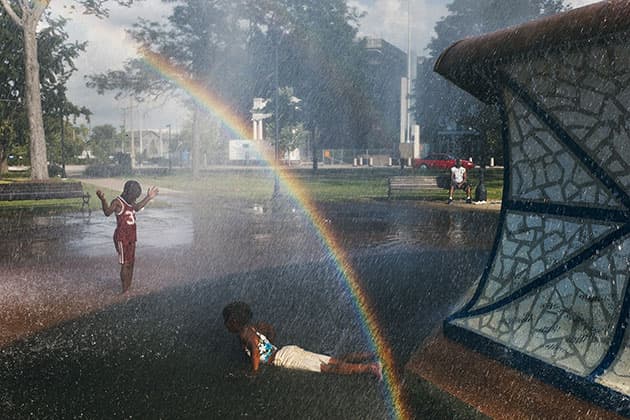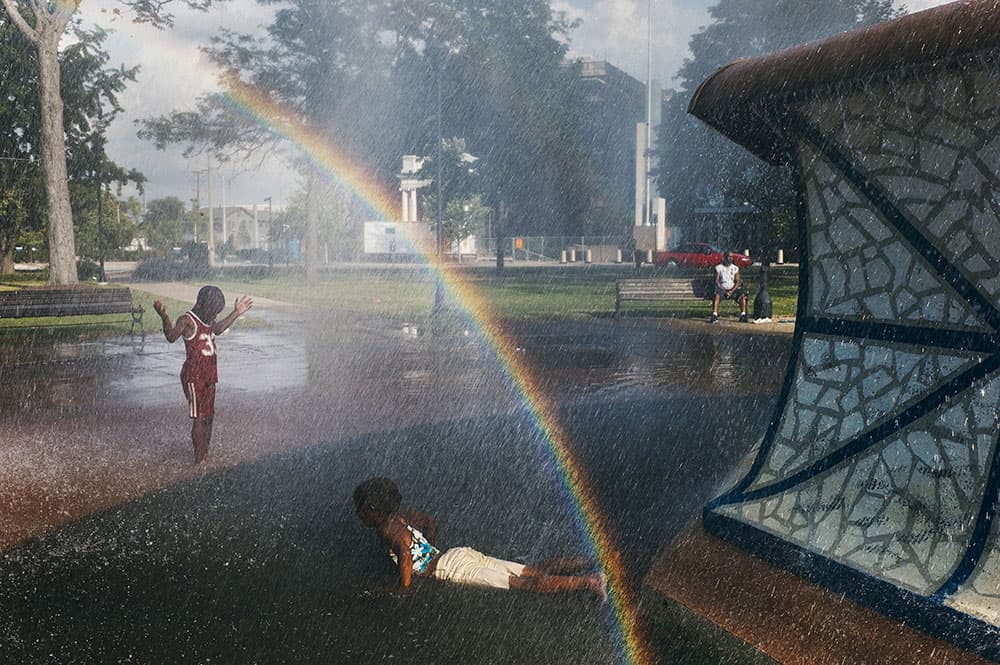
Erie, Pennsylvania, 2010, by Alex Webb
The nature of collaboration is a delicate act. Two bodies must learn to gently orbit one another. Too close and the crash is catastrophic. Too far and the tether between them separates and the two drift off into the void. Perhaps one of the most successful photographic collaborations of recent years also happens to be one that acts as a celebration of loving union. Husband and wife Alex Webb and Rebecca Norris Webb have, as well as producing their own distinct individual bodies of work, also collaborated on a host of projects. This has resulted in three publications: Violet Isle (2009), Alex Webb and Rebecca Norris Webb on Street Photography and the Poetic Image (2014) Memory City (also 2014) and, published recently, Slant Rhymes, the most personal collaboration so far.
The title refers to a term denoting a rhyme formed by words with similar, but not identical, sounds. It’s a perfect encapsulation of the collaboration between Alex and Rebecca. Their images are somehow distinct yet complementary. As Rebecca says, the pair has learned to embrace the gaps between their individual ways of seeing.
Violet Isle, their first collaborative book, began as two separate projects, which they had both worked on individually for some 13 years. Alex was photographing on the streets of Cuba and Rebecca was exploring the unique collections of animals she had discovered all over the island, from private menageries to pigeon societies to quirky natural history museums. For some reason – neither of them can be sure why – they hit upon the notion of combining the work and, at the suggestion of an editor, instead of creating a book of two chapters, interwove their photographs. The result was a more multi-layered portrait of the island.
‘Since that first collaboration a decade ago, we’ve realised that it is best for our photography and relationship – to be working on both our own individual projects as well as on a joint project,’ says Rebecca. ‘Both kinds of project ask different things of us as artists and as human beings. In the end, it’s about striking the right balance creatively.’
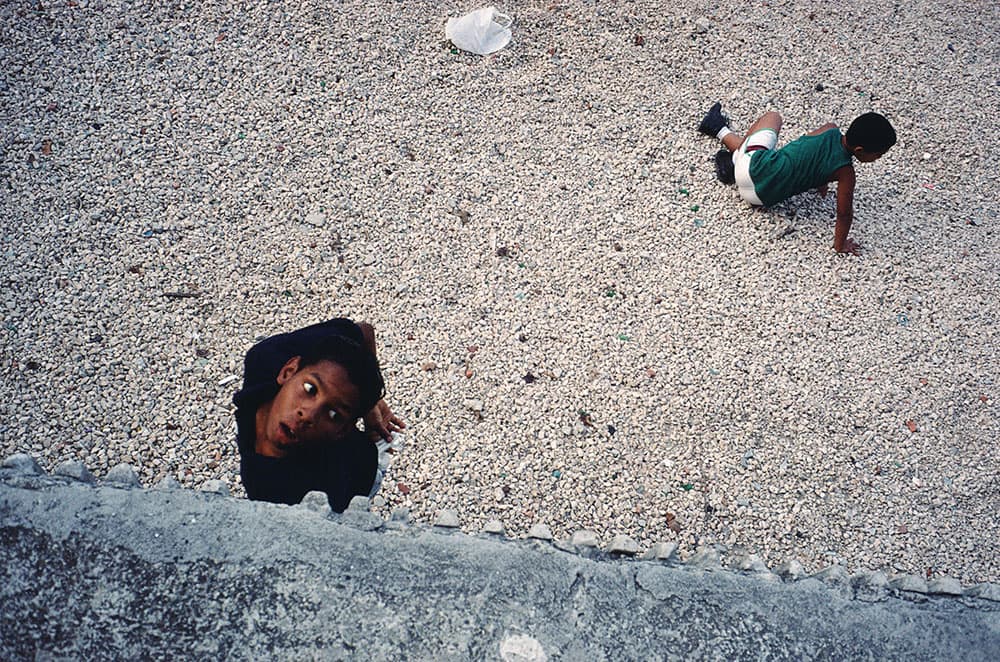
Havana, Cuba, 2001 by Alex Webb
Different strokes
Alex’s work has become famous for the layering of elements, almost to the point that the compositions threaten to spill over into visual chaos (though, importantly, never do). The photographer Dayanita Singh famously described Alex’s colour – and light-saturated images as ‘migraine photographs’. Rebecca’s images, on the other hand, are deeply poetic in their nature and are especially notable for their ephemeral subtlety. Rebecca began her career as a poet and it’s this sensitivity that infuses her images.
‘It’s been a bit of a mystery to us how well our photographs seem to work together,’ says Alex. ‘In trying to analyse it, it seems that more than anything else, both of us seem to respond to a slight sense of surrealism. Both of us are intrigued by the enigmatic, the inexplicable. But it seems as if our respective forms of photographic surrealism are in different keys.’
Both Alex’s and Rebecca’s approaches to photography of course rely on them ‘seeing’ a scene differently. This inevitably involves them approaching projects from rather distinct positions. In their own ways, they both rely on a kind of instinct. Alex’s instinct places him very much in the moment of the immediate environment. Rebecca’s seems much more concerned with traces, memory and history.
‘It’s impossible to generalise about what I’m drawn to,’ Alex says. ‘I guess I sense the possibility of a photograph, I almost “smell” it: a shaft of light, a gathering of people, a bit of a poster, an alleyway. I hang out, I watch, and sometimes something unexpected happens that somehow transforms the mundane into something more intriguing.’
On the other hand, Rebecca says that when a landscape calls, she follows. ‘How I work is akin to a kind of listening – seeing as a way of listening deeply to the rhythm and the stillness of my first landscape, one that’s rich with memory and poetic resonance.’
Alex explains that Slant Rhymes is a visual conversation between Rebecca and himself. They paired photographs that they made or shared over the course of their long relationship, from their initial rich friendship in 1988, to their marriage in 1999, and then to their subsequent collaborations.
‘Sometimes the images are linked by a shared palette,’ says Alex. ‘Sometimes by formal concerns, sometimes by the same geography, and often by a mutual penchant for the surreal or surprising moment.’
‘We like to think that underneath Slant Rhymes is a kind of unfinished, elliptical love poem that spans the nearly-30 years we’ve know each other,’ says Rebecca. ‘Also, like with the most surprising metaphors, some of our paired images require you to take an imaginative leap in order to fly over the sometimes deep visual divide that separates our two very different ways of seeing.’
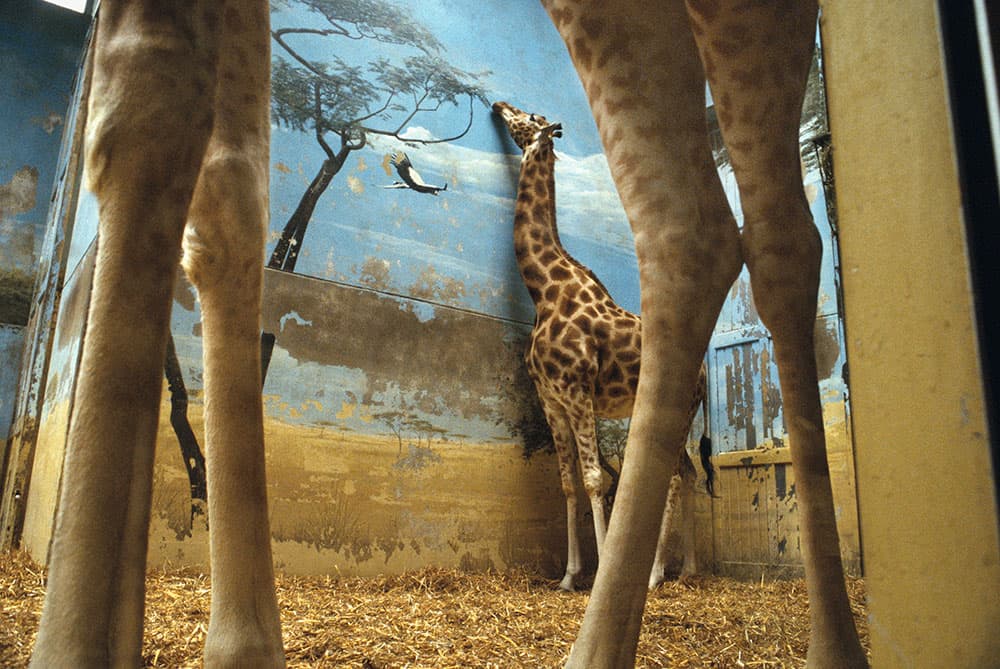
Giraffes, Paris, 2006, by Rebecca Norris Webb
From film to digital
What’s especially interesting looking back through the work of Alex and Rebecca is seeing two photographers who have both navigated their way through the transition from film to digital. It’s a process that’s likely to be familiar to many readers, and is especially significant when viewing the work of two key photographers who have had to almost shift the parameters of their processes in order to accommodate it.
‘My decision to start working digitally was largely prompted by the end of Kodachrome, the colour transparency film I had used since the late 1970s,’ Alex explains. ‘My initial reservations about digital were twofold: I didn’t like digital’s intangibility. I could touch a transparency but not a bunch of bits. This still bothers me, but now, since starting to work digitally, I always make work prints of any images that I care about, just to be able to hold them.
‘My second reservation was the thinness of digital files. Prints from digital files didn’t seem to have the richness and texture and soul that those from film did, a bit like the way musicians have criticised CDs for not having the soulfulness that vinyl does. I’ve learned to work with my printer, usually adding a little grain to the files, to give digital prints a bit more texture and soul. They’re different than those from film, but I now like what we are managing to produce.’
‘Memory City, which came out in 2014, ended up being my last book in which I solely used film. So, needless to say, it’s been a difficult couple of years for me while making the transition. It’s only recently that I feel I’ve found my rhythm while working digitally, a creative process with its own unique struggles and unexpected benefits. Unlike working with film, I can now edit late at night in the same landscape where I’m photographing, allowing me to immerse myself more deeply. Last night, for instance, while editing my photographs on the same floodplain where my dad grew up, I was serenaded by a couple of barred owls.’
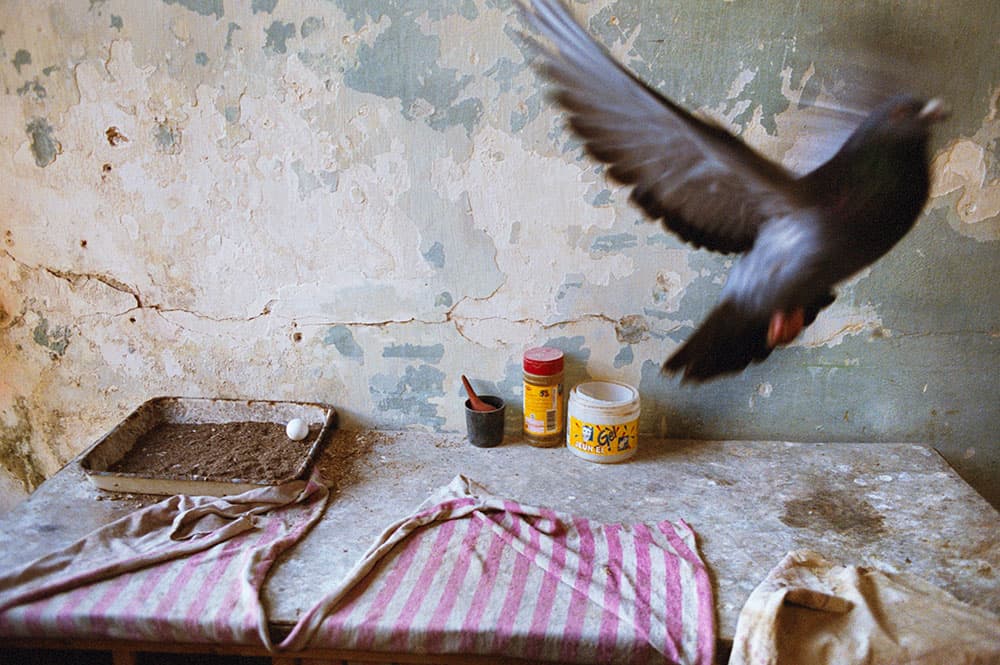
Blackbirds, Dakota, US, 2012, Rebecca Norris Webb
Shifting landscapes
This all begs the question as to how the pair sees the photography world now. In their view, is it in an especially healthy place with the proliferation of smartphones and social media?
‘Right now, I’m very intrigued that as the possibilities of publishing a book of photographs through traditional publishing channels have diminished, photography books have proliferated,’ says Alex. ‘More and more photographers are figuring out ways to publish their own books, whether themselves or through small independent publishing houses. It’s almost as if the intangibility of the internet and the nature of the digital image have resulted in a need for the tangible photography book.
‘It’s also interesting to note that with the proliferation of cell phones, it seems as if no significant event in the world these days will go un-photographed,’ he continues. ‘Someone, somehow, will have a cell phone and take a photograph, be it the American soldier photographing a hooded prisoner in Abu Ghraib, or an Iranian photographing a protest that his government does not want documented. Having said that, there are so many mundane, banal images coursing through the internet that it’s easy to miss the truly special images.’
‘As two of the last analogue dinosaurs, Alex and I have only relatively recently traded our flip phones for smartphones,’ says Rebecca. ‘We’ve long been interested in the relationship between text and images and how the two can illuminate one other. I was immediately intrigued with experimenting with Instagram, since it allows you to post accompanying texts along with your photographs. So Alex and I came up with the idea of Slant Rhymes – posting one of his images that visually rhymes with one of mine – as a way of creatively playing and expanding on this notion. So, in essence, Instagram became a kind of sketchbook for us. When the publisher La Fábrica came to us a few months later, inviting us to do a book with them, we immediately thought of Slant Rhymes. So, in part, we have Instagram to thank for what eventually became an analogue project.’
Next up, the pair is working on a collaborative project about Brooklyn, NY, where they’ve lived together for nearly 20 years, called The City Within.
‘At the same time, we’re both working on two independent projects,’ says Alex. ‘I’m currently photographing in Memphis, part of a larger project about US cities. As I say this, Rebecca is photographing in Rush County, Indiana, on Night Calls, a tribute to her country-doctor father. He was a contemporary of the Colorado country doctor whom Eugene Smith photographed for Life magazine in 1948.’
While we often take the view that artists, and photographers especially, are ‘lone gunmen’, it’s heartening to see the benefits of collaboration, particularly with two individuals so in tune with one another. There’s something to be noted there. If you’re looking to take your photography in a new direction, consider that perhaps there is someone close by who can help you do just that. Who knows what the result will be?
To see more of their work, visit www.webbnorriswebb.co. Slant Rhymes is published by La Fábrica and is priced at £34.

Havana, Cuba, 2007, by Rebecca Norris Webb
Alex Webb is a Magnum photographer who has published several notable books and been exhibited across the world. Rebecca Norris Webb, originally a poet, has produced several books, all of which combine image and text.

